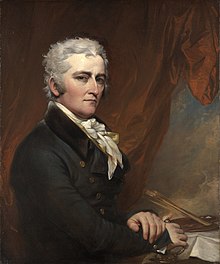John Trumbull
| John Trumbull | |
|---|---|

Self-portrait, c. 1802
|
|
| Born |
June 6, 1756 Lebanon, Colony of Connecticut, British America |
| Died | November 10, 1843 (aged 87) City of New York, New York, U.S. |
| Nationality | American |
| Education | with Benjamin West |
| Known for | Painting |
| Notable work | Declaration of Independence (1817-1819) |
John Trumbull (June 6, 1756 – November 10, 1843) was an American artist during the period of the American Revolutionary War and was notable for his historical paintings. His Declaration of Independence (1817) was used on the reverse of the two-dollar bill.
Trumbull was born in Lebanon, Connecticut, in 1756, to Jonathan Trumbull and his wife Faith (née Robinson) Trumbull. His father served as Governor of Connecticut from 1769 to 1784. Both sides of his family were descended from early Puritan settlers in the state.
The young Trumbull entered the 1771 junior class at Harvard College at age fifteen and graduated in 1773. Due to a childhood accident, Trumbull lost use of one eye, which may have influenced his detailed painting style.
As a soldier in the American Revolutionary War, Trumbull rendered a particular service at Boston by sketching plans of the British works. He witnessed the Battle of Bunker Hill. He was appointed second personal aide to General George Washington, and in June 1776, deputy adjutant-general to General Horatio Gates. He resigned from the army in 1777 after a dispute over the dating of his officer commission.
In 1780 he traveled to London, where he studied under Benjamin West. At West's suggestion, Trumbull painted small pictures of the War of Independence and miniature portraits. He painted about 250 in his lifetime.
...
Wikipedia
